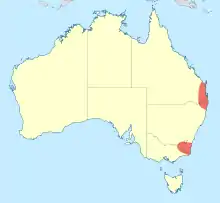Acanthaeschna victoria
Acanthaeschna victoria, the thylacine darner,[4] is a species of Australian dragonfly in the family Telephlebiidae.[5] It is the only member of the genus Acanthaeschna.[6][7] Acanthaeschna victoria is rare and endemic to coastal areas of both southern and northern New South Wales as well as southern Queensland. Its natural habitat is intertidal marshes. It is threatened by habitat loss.
| Thylacine darner | |
|---|---|
 | |
| Male | |
| Scientific classification | |
| Kingdom: | Animalia |
| Phylum: | Arthropoda |
| Class: | Insecta |
| Order: | Odonata |
| Infraorder: | Anisoptera |
| Family: | Telephlebiidae |
| Genus: | Acanthaeschna Selys, 1883[2] |
| Species: | A. victoria |
| Binomial name | |
| Acanthaeschna victoria | |
 | |
Acanthaeschna victoria is a large, brown dragonfly with a distinctive dark band on the side of its body that runs from the head to the abdomen.[8] It has clear wings[4] with a small dark stain at the nodus, the joint near the middle of the leading edge of each wing.
Gallery
.jpg.webp) Female
Female.jpg.webp) Female from below
Female from below.jpg.webp) Female showing a broad dark band on the side of her body
Female showing a broad dark band on the side of her body.jpg.webp) Eyes
Eyes.jpg.webp) Female wings
Female wings.jpg.webp) Male wings
Male wings
References
| Wikimedia Commons has media related to Acanthaeschna victoria. |
- Dow, R.A. (2017). "Acanthaeschna victoria". IUCN Red List of Threatened Species. 2017: e.T43A14255260. doi:10.2305/IUCN.UK.2017-1.RLTS.T43A14255260.en.
- Selys-Longchamps, E (1883). "Synopsis des Aeschnines. Première partie: Classification". Bulletin de la Classe des Science, Académie Royale de Belgique. 3 (in French). 5: 712–748 [732] – via Biodiversity Heritage Library.
- Martin, Rene (1901). "Les odonates du continent australien". Mémoires de la Société Zoologique de France (in French). 14: 220–248 [233] – via Biodiversity Heritage Library.
- Theischinger, Günther; Hawking, John (2006). The Complete Field Guide to Dragonflies of Australia. Collingwood, Victoria, Australia: CSIRO Publishing. p. 134. ISBN 978 0 64309 073 6.
- "Species Acanthaeschna victoria Martin, 1901". Australian Faunal Directory. Australian Biological Resources Study. 2012. Retrieved 28 January 2012.
- Martin Schorr; Martin Lindeboom; Dennis Paulson. "World Odonata List". University of Puget Sound. Archived from the original on 28 August 2010. Retrieved 11 August 2010.
- "Genus Acanthaeschna Selys, 1883". Australian Faunal Directory. Australian Biological Resources Study. 2012. Retrieved 24 April 2017.
- Theischinger, Gunther; Endersby, Ian (2009). Identification Guide to the Australian Odonata (PDF). Department of Environment, Climate Change and Water NSW. p. 245. ISBN 978 1 74232 475 3.
This article is issued from Wikipedia. The text is licensed under Creative Commons - Attribution - Sharealike. Additional terms may apply for the media files.
